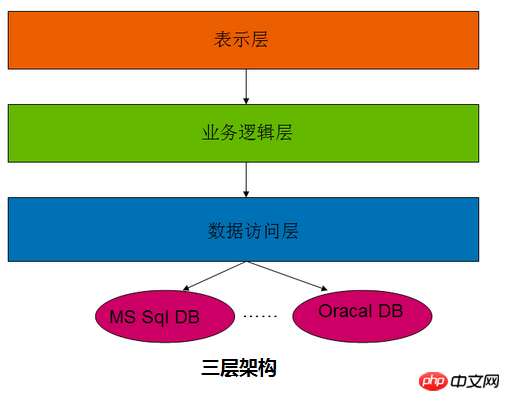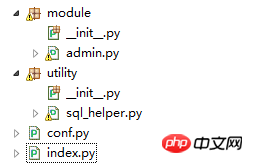 Backend Development
Backend Development
 Python Tutorial
Python Tutorial
 Detailed graphic explanation of python three-tier architecture
Detailed graphic explanation of python three-tier architecture
Detailed graphic explanation of python three-tier architecture
Detailed graphic explanation of this articlepythonThree-tierArchitecture
Three-tier architecture (3-tier architecture) Usually The three-tier architecture in the sense is to divide the entire business application into:
Presentation layer (Presentation layer), Business Logic Layer (Business Logic Layer), Data Access Layer (Data access layer).
#The purpose of distinguishing levels is the idea of "high cohesion and low coupling".
High cohesion and low coupling is a concept in software engineering and a standard for judging the quality of a design. It is mainly object-oriented design, mainly based on the cohesion of classes. Whether the sex is high and the degree of coupling is low.
Cohesion is how closely the elements in a module are combined with each other. High cohesion is how closely the elements in a module are combined with each other.
The so-called high cohesion means that a software module is composed of highly related codes and is only responsible for one task, which is often referred to as the single responsibility principle.
Coupling: A measure of the degree of interconnection between different modules within a software structure (coupling is also called inter-block connection. It refers to a measure of the closeness of the interconnection between modules in a software system structure.
The closer the connection between modules, the stronger the coupling, and the worse the independence of the module. The level of coupling between modules depends on the complexity of the interface between modules. , the method of calling and the information passed.)
For low coupling, the superficial understanding is:
A complete system, as far as possible between modules. to make it exist independently.
In other words, let each module complete a specific sub-function independently as much as possible.
The interfaces between modules should be as few and simple as possible.
If the relationship between two modules is relatively complex, it is best to consider further module division first.
This is conducive to modification and combination.
Three-tier architecture, as shown below:

2. Business logic layer (BLL): operations for specific problems, which can also be said to be operations on the data layer and processing of data business logic.
3. Data Access Layer (DAL): The transactions done by this layer directly operate the database, for data addition,
deletion, modification, search, etc.

#coding:utf8
from utility.sql_helper import MySqlHelper
class Admin(object):
def init(self):
self.helper = MySqlHelper()
def Get_One(self,id):
sql = "select * from userinfo where id = %s"
params = (id,)
return self.helper.Get_One(sql, params)
def CheckValidate(self,username,password):
sql = "select * from userinfo where name=%s and password=%s"
params = (username,password,)
return self.helper.Get_One(sql, params)#coding:utf8
import MySQLdb
import conf
class MySqlHelper(object):
def init(self):
self.conn_dict = conf.conn_dict
def Get_Dict(self,sql,params):
conn = MySQLdb.connect(**self.conn_dict)
cur = conn.cursor(cursorclass = MySQLdb.cursors.DictCursor)
reCount = cur.execute(sql,params)
data = cur.fetchall()
cur.close()
conn.close()
return data
def Get_One(self,sql,params):
conn = MySQLdb.connect(**self.conn_dict)
cur = conn.cursor(cursorclass = MySQLdb.cursors.DictCursor)
reCount = cur.execute(sql,params)
data = cur.fetchone()
cur.close()
conn.close()
return data#coding:utf8
conn_dict = dict(
host='127.0.0.1',
user='root',
passwd='123456',
db ='Admin'
)#coding:utf8
from module.admin import Admin
def main():
user=raw_input('username:')
pwd=raw_input("password:")
admin = Admin()
result = admin.CheckValidate(user, pwd)
if not result:
print '用户名或密码错误'
else:
print '进入后台登录界面'
if name== 'main':
main()The above is the detailed content of Detailed graphic explanation of python three-tier architecture. For more information, please follow other related articles on the PHP Chinese website!

Hot AI Tools

Undresser.AI Undress
AI-powered app for creating realistic nude photos

AI Clothes Remover
Online AI tool for removing clothes from photos.

Undress AI Tool
Undress images for free

Clothoff.io
AI clothes remover

Video Face Swap
Swap faces in any video effortlessly with our completely free AI face swap tool!

Hot Article

Hot Tools

Notepad++7.3.1
Easy-to-use and free code editor

SublimeText3 Chinese version
Chinese version, very easy to use

Zend Studio 13.0.1
Powerful PHP integrated development environment

Dreamweaver CS6
Visual web development tools

SublimeText3 Mac version
God-level code editing software (SublimeText3)

Hot Topics
 1662
1662
 14
14
 1419
1419
 52
52
 1313
1313
 25
25
 1262
1262
 29
29
 1235
1235
 24
24
 Python vs. C : Applications and Use Cases Compared
Apr 12, 2025 am 12:01 AM
Python vs. C : Applications and Use Cases Compared
Apr 12, 2025 am 12:01 AM
Python is suitable for data science, web development and automation tasks, while C is suitable for system programming, game development and embedded systems. Python is known for its simplicity and powerful ecosystem, while C is known for its high performance and underlying control capabilities.
 The 2-Hour Python Plan: A Realistic Approach
Apr 11, 2025 am 12:04 AM
The 2-Hour Python Plan: A Realistic Approach
Apr 11, 2025 am 12:04 AM
You can learn basic programming concepts and skills of Python within 2 hours. 1. Learn variables and data types, 2. Master control flow (conditional statements and loops), 3. Understand the definition and use of functions, 4. Quickly get started with Python programming through simple examples and code snippets.
 Python: Games, GUIs, and More
Apr 13, 2025 am 12:14 AM
Python: Games, GUIs, and More
Apr 13, 2025 am 12:14 AM
Python excels in gaming and GUI development. 1) Game development uses Pygame, providing drawing, audio and other functions, which are suitable for creating 2D games. 2) GUI development can choose Tkinter or PyQt. Tkinter is simple and easy to use, PyQt has rich functions and is suitable for professional development.
 How Much Python Can You Learn in 2 Hours?
Apr 09, 2025 pm 04:33 PM
How Much Python Can You Learn in 2 Hours?
Apr 09, 2025 pm 04:33 PM
You can learn the basics of Python within two hours. 1. Learn variables and data types, 2. Master control structures such as if statements and loops, 3. Understand the definition and use of functions. These will help you start writing simple Python programs.
 Python vs. C : Learning Curves and Ease of Use
Apr 19, 2025 am 12:20 AM
Python vs. C : Learning Curves and Ease of Use
Apr 19, 2025 am 12:20 AM
Python is easier to learn and use, while C is more powerful but complex. 1. Python syntax is concise and suitable for beginners. Dynamic typing and automatic memory management make it easy to use, but may cause runtime errors. 2.C provides low-level control and advanced features, suitable for high-performance applications, but has a high learning threshold and requires manual memory and type safety management.
 Python and Time: Making the Most of Your Study Time
Apr 14, 2025 am 12:02 AM
Python and Time: Making the Most of Your Study Time
Apr 14, 2025 am 12:02 AM
To maximize the efficiency of learning Python in a limited time, you can use Python's datetime, time, and schedule modules. 1. The datetime module is used to record and plan learning time. 2. The time module helps to set study and rest time. 3. The schedule module automatically arranges weekly learning tasks.
 Python: Exploring Its Primary Applications
Apr 10, 2025 am 09:41 AM
Python: Exploring Its Primary Applications
Apr 10, 2025 am 09:41 AM
Python is widely used in the fields of web development, data science, machine learning, automation and scripting. 1) In web development, Django and Flask frameworks simplify the development process. 2) In the fields of data science and machine learning, NumPy, Pandas, Scikit-learn and TensorFlow libraries provide strong support. 3) In terms of automation and scripting, Python is suitable for tasks such as automated testing and system management.
 Python: Automation, Scripting, and Task Management
Apr 16, 2025 am 12:14 AM
Python: Automation, Scripting, and Task Management
Apr 16, 2025 am 12:14 AM
Python excels in automation, scripting, and task management. 1) Automation: File backup is realized through standard libraries such as os and shutil. 2) Script writing: Use the psutil library to monitor system resources. 3) Task management: Use the schedule library to schedule tasks. Python's ease of use and rich library support makes it the preferred tool in these areas.



